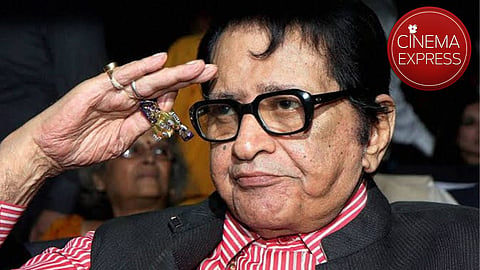

One of my last enduring memories of actor-filmmaker Manoj Kumar is of him wearing an orange Shirdi Sai Baba bandana, wheelchair-bound but in great cheer, receiving the Dadasaheb Phalke award—India’s highest honour in cinema—for the year 2015 from the then President Pranab Mukherjee. A rare public appearance for someone who had nearly retreated into anonymity even though his brand of patriotic cinema, something that he is most recognised and feted for, has seen a major rejuvenation, resurgence, and magnification in the last decade.
It wouldn’t be an exaggeration to say that identifying Kumar with earnest flag-waving started with his most seminal performance as the young revolutionary of India’s freedom struggle, Bhagat Singh. S Ram Sharma’s 1965 film Shaheed, supposedly ghost-directed by Kumar himself, has given generations of Indians goosebumps, especially moments like Bhagat Singh with his palm on a burning candle taking the vow to lay down his life for the nation in the Prem Dhawan composition sung by Mohammad Rafi, “Aye watan aye watan, humko teri kasam, teri raahon mein jaan tak luta jaayenge”. Or Bhagat Singh, Rajguru and Sukhdev cheerfully singing another Dhawan song “Mera rang de basanti chola” on their way to getting executed.
Kumar’s on-screen nationalism grew further in a more categorical context—that of the Indo-Pakistan war of 1965. It also owed allegiance to the then Prime Minister of India, Lal Bahadur Shastri, who, as per an unconfirmed legend, was so impressed with Kumar in Shaheed that he approached him to direct a film based on his slogan “Jai Jawan, Jai Kisan” and Upkar (1967) was born. However, Shastriji died in January 1966 after signing the Tashkent agreement and couldn’t watch and endorse the film that was presented as a tribute to him. Kumar’s directorial debut had him play Bharat, a farmer turned soldier and highlighted the kisan-jawan contribution to the progress of the nation by symbolically juxtaposing a gun against the plough. Kumar himself referred to the film as “Bharat ka 16,000-foot lamba celluloid flag (a 16,000-foot-long celluloid flag of India)”. Music brought things full circle with “Mere desh ki dharti”, composed by Kalyanji Anandji, written by Gulshan Bawra and sung by Mahendra Kumar emerging as one of the most popular patriotic Hindi film songs of all time.
Bharat became Kumar’s adopted name in Purab aur Paschim (1970), Roti Kapda Aur Makaan (1974), Kranti (1981) and Clerk (1989), the reason why he came to be called Bharat Kumar of Hindi cinema. However, before the patriot games, Kumar’s career was typically that of a regular boyish romantic hero in love triangles and quadrangles like Hariyali Aur Raasta (1962), Himalay Ki God Mein (1965) Do Badan (1966), Patthar Ke Sanam (1967) and Aadmi (1968) and the dapper dude in popular suspense thrillers like Woh Kaun Thi? (1964), Gumnaam (1965), Anita (1967) and Neel Kamal (1968). In Kumar’s second nation-centric film as a director, Purab Aur Paschim, the love and allegiance for the country is absolute and unconditional. It is, in fact, an assertion of civilisational superiority with the hero bringing the strayed, Westernised Indian diaspora in London back to the fold of traditional morals, values and ideals. Kranti was about the spark of resistance against the British rule in 19th-century India.
But it is in the Indira Gandhi-era Roti Kapda Aur Makaan that Kumar cast a more complex and critical gaze at the state of the nation. There is no enemy out there—no Britain or Pakistan—but the issues within, of unemployment, poverty, economic disparities, crime and corruption and glaring lack of basic necessities, are enough to drive an average family up the wall. Patriotism that was more public-spirited than shrill. Though Kumar’s cinema is perceived as quintessentially nationalistic, there was more to him than flag-waving. With Ashok V Bhushan’s 1977 hit Shirdi Ke Sai Baba, which Kumar penned, he brought the saint, revered by both Hindus and Muslims, into the realm of popular faith and spirituality. A well-known figure in Maharashtra, Sai Baba came to be embraced by the entire India. I would rate Shor (1972)—about the twin faculties, of talking and listening—as Kumar’s standout creation. Written, directed, edited and produced by him, the film has a twist in the tale that sees a cataclysmic cosmic irony at play. Quite like O Henry’s short story The Gift of The Magi.
A below-par film like Clerk and his increasingly mannered acting style like the habit of covering his face with his hand may have become fodder for caricaturising, most notably in Farah Khan’s Om Shanti Om and, somewhere on the way, a singular and innovative aspect of Kumar’s filmmaking was not reflected on and celebrated well enough—the way he imagined and shot songs. Like the choreographic tempo emerging from everyday activities in the fields in “Mere desh ki dharti” or the way he foregrounds a face and frames it against a crowd in the background in “Aayi jhoom ke basant”, both in Upkar. There’s a similar rhythm to the regular in “Purva suhani aayi re” in Purab aur Paschim with a prelude underlining India’s secularism and multiculturalism. “Koi jab tumhara hriday tod de” here has a gentle stillness and gravitas like “Kasme vade pyaar wafa sab” in Upkar.
He used the revolving seating in a restaurant to great effect in creating a sense of movement in an otherwise staccato commemoration of India—"Hai preet jahan ki reet sada”. Just like non-stop cycling in “Jeevan chalne ka naam” in Shor became a metaphor for the continuum of life.
“Ek pyaar ka naghma hai” and “Shehnai baje na baje” in the same film and “Main na bhoolunga” in Roti Kapda Aur Makaan had him use his favourite optical device of mirroring and reflection and play of multiple images like in a kaleidoscope. Cinema as a florescent fantasy rooted in the real.